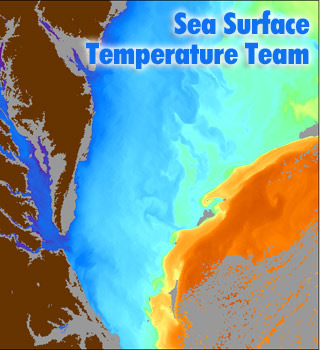 Sea Surface Temperature Team
The Sea Surface Temperature Team is responsible for the development, science
maintenance and validation of various Level 2, 3 and 4 SST products from current
and future polar and geostationary satellites. We work with our partners in the
NOAA Office of Satellite Products and Operations (OSPO), to generate high-
quality SST products and satisfy needs of NOAA and external users, in the areas
of climate monitoring, seasonal forecasting, operational weather and ocean
forecasting, military and defense operations, validating of ocean and
atmospheric models, ecosystem assessment, tourism, and fisheries. We also
participate in the international Group for High Resolution SST.
NOAA Enterprise SST System comprises 2 sub-systems:
Retrieval and Monitoring
Retrieval:
- ACSPO (Advanced Clear-Sky Processor for Ocean)
-
Monitoring:
- SQUAM - SST Quality Monitor
-
| Purpose: |
- Monitors global L2 & L3 SSTs w.r.t. L4 fields & in situ data
- Intercompares and validates various global L4 SST products
|
| Site: |
www.star.nesdis.noaa.gov/sod/sst/squam/ |
| Reference: |
Dash, P., Ignatov, A., Kihai, Y., & Sapper, J. (2010). The
SST Quality Monitor (SQUAM). Journal of Atmospheric and
Oceanic Technology, 27(11), 1899-1917. [10.1175/2010jtechho756.1]
|
- Global SST Monitoring & Validation against in situ SSTs (iQuam)
-
- Match-Up Code
-
| Purpose |
Generate satellite/iQuam match-ups for analysis in SQUAM |
- ARMS - ACSPO Regional Monitor for SST
-
- MICROS - Monitoring IR Clear-sky Radiances over Oceans for SST
-
| Purpose |
Global monitoring clear ocean BTs vs. CRTM, to ensure high-quality brightness temperatures |
| Site: |
www.star.nesdis.noaa.gov/sod/sst/micros/ |
| Reference: |
Liang, X. M., & Ignatov, A. (2011). Monitoring of IR Clear-Sky Radiances over Oceans for SST (Micros).
Journal of Atmospheric and Oceanic Technology, 28(10), 1228-1242.
[10.1175/jtech-d-10-05023.1] |
- 3S - Sensor Stability for SST
-
| Purpose |
Monitoring of AVHRR L1b data, to ensure high quality CAL for accurate brightness temperatures |
| Site: |
www.star.nesdis.noaa.gov/sod/sst/3s/ |
| Reference: |
He, K., Ignatov, A., Kihai, Y., Cao, C., &
Stroup, J. (2016). Sensor Stability for SST (3S): Toward Improved Long-Term Characterization of
AVHRR Thermal Bands. Remote Sensing, 8(4), 346. [10.3390/rs8040346] |
|

